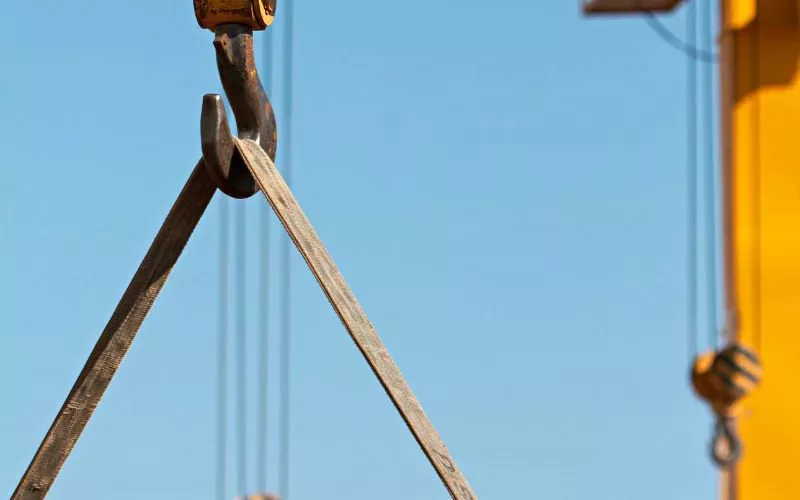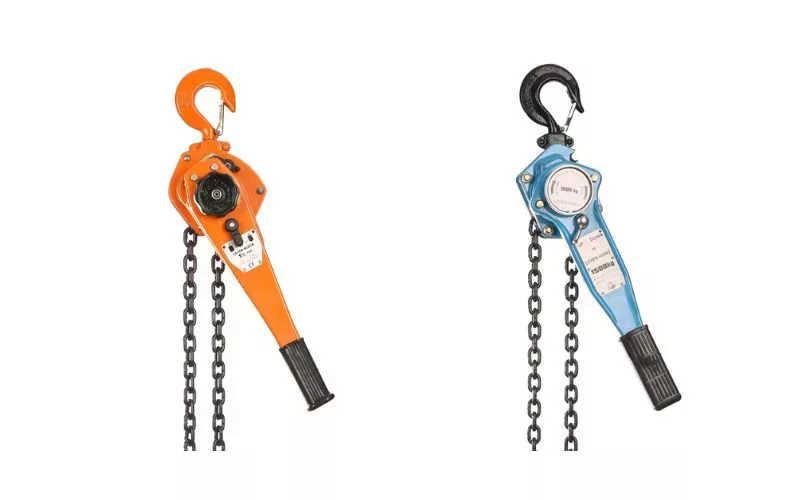
In the world of construction, manufacturing, and industrial operations, lifting and moving heavy loads is a critical task that requires specialized equipment. Two of the most commonly used machines for this purpose are hoists and cranes. While both are designed to lift and lower objects, they have distinct differences in their design, capabilities, and applications.
Understanding the differences between cranes and hoists, their components, and their applications is crucial for selecting the right equipment for a specific lifting task and ensuring safe and efficient operations. In this article, we will delve deeper into the key distinctions between these two lifting machines and explore their roles in various industries.
Why Do People Confuse a Hoist and a Crane?
You might find yourself mixing up a hoist and a crane, and you’re not alone in this. The terms are often used interchangeably, but they describe different equipment. Here are a few reasons why this confusion is common:
- Similar Functions: Both cranes and hoists are involved in the lifting process, which can lead to the impression that they are the same thing. They work together to move heavy materials, but they play distinct roles within this task.
- Visual Overlap: In many workplaces, especially construction sites, hoists are part of crane assemblies. You might see a hoist attached to a crane, making it challenging to distinguish where one ends and the other begins.
- Linguistic Habits: Sometimes, people may refer to the whole lifting system as a “hoist,” because the hoist is crucial for the actual lifting. This habit contributes to confusion about each piece of equipment’s function.
Main Difference Between Crane and Hoist
When you’re looking at the machinery on a construction site, you might see both cranes and hoists in action. It’s important to understand that, despite their similar functions, they serve distinct purposes.
The main differences between a hoist and a crane are their components, range of motion, and applications:
- Components: A hoist is a single component that performs the lifting, while a crane is a more complex machine that incorporates a hoist along with other components, like a trolley and bridge, to enable multi-directional movement.
- Range of Motion: Hoists can only move loads vertically up and down along a single axis. In contrast, cranes can move loads both vertically and horizontally, providing multi-directional mobility to transport loads across a work area.
- Applications: Hoists are suitable for lifting heavy loads straight up and down in a fixed location. Cranes provide greater flexibility and are used when loads need to be lifted and also moved horizontally to different positions. Cranes provide full coverage of a factory floor or work site.
What is the Crane

A crane is a powerful machine that combines simple machines to lift and move heavy loads with a boom, hoist, and pulley system, and comes in many configurations to suit different lifting applications in construction, manufacturing, transportation, and other industries
Common Types of Crane
Cranes can be stationary or mobile:
- Mobile Cranes:
- All-Terrain Cranes: Equipped with tires and a strong chassis, they can navigate across various surfaces, from city streets to rough, uneven terrains.
- Rough Terrain Cranes: Designed for challenging outdoor environments with off-road tires, four-wheel drive, telescopic booms, and outriggers for maneuverability in tight spaces.
- Truck-Mounted Cranes: Mounted on trucks for easy transportation between locations, they offer rapid setup and relocation.
- Crawler Cranes: Fitted with tracks for stability and mobility across challenging landscapes, they are used for large-scale projects like bridge construction and infrastructure work.
- Tower Cranes:
- Hammerhead Cranes: Resembling an upside-down L, the jib remains at a set level and can rotate, commonly used on loading docks and tight construction sites.
- Luffing Tower Cranes: Similar to hammerhead cranes but with a jib that can be raised and lowered, providing added flexibility and efficiency in smaller spaces.
- Self-Erecting Cranes: Designed for easy setup and dismantling, they are ideal for short-term jobs and tight spaces but have lower lifting capacities.
- Overhead Cranes:
- Bridge Cranes: Consisting of two beams with a hoist that travels along the bridge, used in industrial settings to move loads through overhead space.
- Gantry Cranes: A type of bridge crane supported by A-frame steel posts, commonly used at shipping docks and ports.
- Jib Cranes: Wall or floor-mounted cranes with a movable hoist, used for repetitive tasks at workstations.
- Telescopic Cranes: Equipped with a hydraulic boom that can change length like a telescope, they are highly adaptable for various situations and often truck-mounted for transportation.
- Floating Cranes: Used for marine and offshore projects, they are mounted on barges or ships and feature advanced stabilization systems to counter currents and waves.
Main Components of Crane
- Hook: The hook is one of the most recognizable and important parts of a crane. It is the main connecting point between the crane and the load being lifted.
- Hoist: The hoist is the component responsible for lifting and lowering the hook and the attached load. It consists of a cable drum, motor, and gearing.
- Boom: The boom is the large, extendable arm that holds the load. It allows the crane to move heavy items and send materials far from the base. There are two types of booms: lattice booms (made of structural steel) and hydraulic booms (using hydraulic cylinders to extend and retract).
- Jib: The jib is an arm that extends horizontally from the boom, providing extra reach when needed to move larger or longer loads that require the crane to be farther away during movement.
- Counterweights: Counterweights are large, heavy masses attached to the crane’s rotating base. They prevent the crane from tipping over when lifting heavy loads by balancing the weight.
- Outriggers: Outriggers are extendable arms with pads that extend horizontally from the crane’s base. They provide stability and support, preventing the crane from tipping over during operation.
- Operator’s Cab: The operator’s cab is where the crane operator sits and controls the crane’s movements using various levers, pedals, and switches.
What are the applications of crane?
- Construction: Cranes play a pivotal role in constructing buildings, bridges, and other structures.
- Manufacturing: They move raw materials, parts, and finished products throughout factories.
- Transportation: Cranes load and unload heavy goods in ports and rail yards.
- Energy: Used in the erection of wind turbines and the maintenance of electric power transmission lines.
What is the Hoist

A hoist is a lifting device that utilizes mechanical advantage through pulleys, chains, or cables to raise, lower, or move heavy loads vertically, and can be powered or manually operated depending on the application and requirements.
The common type of hoist
Hoists can be powered manually, electrically, or pneumatically, each suited for specific tasks:
- Electric Hoists: These wire rope hoists are powered by electricity and use a motor to lift and lower loads. They are reliable, versatile, and suitable for a wide range of lifting tasks in various industries
- Manual Hoists: Also known as hand chain hoists, chain blocks, or lever hoists, these hoists are operated manually by pulling a chain or lever. They are portable, easy to use, and ideal for smaller lifting tasks where electricity is not available.
- Pneumatic/Air Hoists: These hoists use compressed air to lift and lower loads. They are suitable for use in hazardous or explosive environments where electric hoists are not safe.
The main components of hoist
Key components that constitute a hoist include:
- Upper Hook or Suspension Means: Connects the hoist to its supporting structure, such as a crane or beam.
- Lower Hook or Load Block: Attaches directly to the load being lifted and consists of a hook, swivel, bearing, sheaves, pins, and frame.
- Hook Latch or Safety Latch: Locks the hook securely onto its attachment point to prevent accidental disengagement.
- Load Chain, Rope, or Wire Rope: The lifting medium that runs between the lower hook and the hoist’s lifting mechanism.
- Drum and Rope Guide: Cylindrical component that guides and wraps the chain/rope around itself as the load is raised or lowered.
- Lifting/Lowering Mechanism: The core of the hoist, typically consisting of gears, pulleys, and a motor that provides the mechanical advantage to lift heavy loads.
- Hoist Frame or Housing: Serves as the structural backbone of the hoist and contains the lifting mechanism and other key components.
What are the applications of hoist?
Hoists are utilized across various industries, including:
- Construction: For lifting building materials.
- Manufacturing: For assembling heavy machinery.
- Warehousing: To move inventory.
- Automotive: In maintenance and assembly tasks.
- Shipping: For loading and unloading cargo.
Choosing the Right Equipment
When faced with numerous options for material handling, it’s essential to consider your specific needs to ensure maximum efficiency and productivity. Here’s how to choose between a crane and a hoist for your projects.
- Crane:
- Ideal for heavy objects and large cargo.
- Offers a broad range of motion; can move loads vertically, horizontally, and along multiple axes.
- Suitable for expansive project sites where distances are significant.
- Size can vary from smaller mobile cranes to towering tower cranes.
- Hoist:
- The go-to for vertical lifting of materials.
- More compact and fits in smaller spaces where cranes might not be practical.
- Typically handles lighter-weight tasks.
- Elevated productivity in repetitive lifting operations due to its straightforward operation.
Consider the Load: Before selecting equipment, evaluate the weight and size of the material to handle. Here’s how your choice of equipment relates to load capacity:
Your choice should also take into account the frequency of movement and the efficiency required. Cranes are better suited to complex tasks and larger scales of transport, while hoists offer simplicity and speed for more straightforward vertical lifts.
Frequently Asked Questions
What components constitute the hoisting mechanism on a crane?
The hoisting mechanism on a crane typically includes a drum, motor, wire rope or chain, and lifting hook. These components work together to enable the crane to lift and lower loads with precision and control.
What factors distinguish a lift from a hoist in terms of their applications?
A lift generally refers to equipment designed for transporting people or goods between floors within a building, whereas a hoist is focused solely on lifting and lowering goods in an industrial setting. The two terms reflect different use cases – lifts for vertical transportation within structures and hoists for material handling.
In what ways do cranes incorporate hoisting machinery within their design?
Cranes make use of hoisting machinery by integrating a hoist into their structure, often mounted on a trolley that allows movement along a bridge or boom. This combination facilitates both vertical lifting by the hoist and additional movement along the crane’s structure for precise placement of loads.

